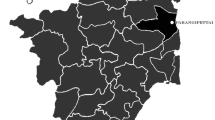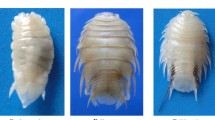Abstract
In this study, a massive infestation of the sea snake Enhydrina schistosa by the cymothoid isopod Nerocila serra, commonly parasitizing fishes, is reported for the first time from India. This isopod was found attached on the different parts of the body of the snake. According to the month, the parasitic prevalence ranged from 30.8 to 55.3%, increasing during the monsson period. It was higher in female than in male snakes.
Similar content being viewed by others
References
Alvarez F, Celis A (2004) On the occurrence of Conchoderma virgatum and Dosina fascicularis (Cirripedia, Thoracica) on the sea snake Pelamis platurus (Reptilia, Serpentes) in Jalisco Mexica. Crustaceana 77(6):761–764
Barnard KH (1936) Isopods collected by the R.I.M.S. “Investigator”. Rec Indian Mus 38:147–191
Bowman TE, Tareen IU (1983) Cymothoidae from fishes of Kuwait (Arabian Gulf) (Crustacea: Isopoda). Smithsonian Contributions to Zoology 382:1–30
Bush AO, Lafferty KD, Lotz JM, Shostak AW (1997) Parasitology meets ecology on its own terms: Margolis et al. Revisited. J Parasitol 83:575–583
Culotta W, Pickwell G (1993) The venomous sea snakes: a comprehensive bibliography. Krieger Publishing Company, Malabar, Florida, pp 432–436
Daniel JC (2002) The book of Indian reptiles and amphibians. Bombay Natural History Society and Oxford University Press, Mumbai, p 238
Dunson WA (1975) Adaptation of sea snakes: pp. 3–19. In: Dunson, W.A, (ed). The biology of sea snakes, University Park press. Baltimore, 530 pp.
Froese R, Pauly D (2011) (eds) Fishbase. World Wide Web electronic publication. www. Fishbase org. Version 2011
Glodek GS, Voris HK (1982) Marine snakes diets: prey composition, diversity and overlap. Copeia 3:661–666
Heatwole H (1999) Sea snakes.University of New South Wales press limited, Sydney, 148 pp.
Herre AW, Rabor DS (1949) Notes on the Philippine Sea snakes of the genus Laticauda. Copeia 4:282–284
Ineich I (1996) Geographic distribution—Serpentes. Hydrophis torquatus diadema. Herpetol Rev 27(3):154
Jayadev Babu S, Sanjeeva Raj PJ (1984) Isopod parasites of fish of Pulicat Lake. Proceedings Symposium of Coastal Aquaculture (Fin Fish) 3:818–823
Lim FLK, Lee MTM (1989) Fascinating snakes of Southeast Asia—an introduction. Tropical Press, Kuala Lumpur, pp 115–117
Margolis L, Esch GW, Holmes JC, Kuris AM, Schad GA (1982) The use of ecological terms in parasitology (report of an ad hoc Committee of the American Society of Parasitologists). J Parasitol 68:131–133
Murthy TSN (1977) On sea snake occurring in Madras waters. J Mar Biol Assoc India 19:68–72
Murthy TSN (1999) Marine reptiles of India: an overview contribution of herpetology. Herpetology 58:35–38
Pillai NK (1954) A preliminary note on the Tanaidacea and Isopoda of Travancore. Bull Cent Res Inst, Univ Travancore 1:1–21
Pillai NK (1960) Ectoproctan-Coelenterate Association: an example of unpurposeful inquilinism? J Bombay nat Hist Soc 57(3):693–694
Rasmussen AR (1993) The status of the Persian Gulf sea snakes Hydrophis lapemoides (Gray, 1849) (Serpentes, Hydrophiidae). Bull Br Mus Nat Hist (Zool. Ser.) 59(2):97–105.
Reynolds RP, Pickwell GV (1984) Records of the yellow-bellied sea snake, Pelamis platurus, from the Galapagos Islands. Copeia 3:786–789
Schioedte JC, Meinert F (1881) Symbolae ad Monographiam Cymothoarum Crustaceorum Isopodum Familiae. II. Anilocridae. Naturhist Tidsskr Ser. III 13: 1-166, pls 1-10.
Smith M (1926) Monograph of the sea-snakes (Hydrophiidae). British Museum (Natural History), London
Suat Ates A, Trilles JP, Ismen A, Cigdem Yigin C (2006) New unusual associations involving parasitic isopods. Crustaceana 79(3):375–380
Trilles JP (1994) Les Cymothoidae (Crustacea, Isopoda) du Monde (Prodrome pour une Faune). Stud Mar 21(22):1–288
Trilles JP, Öktener A (2004) Livoneca sinuata (Crustacea; Isopoda; Cymothoidae) on Loligo vulgaris from Turkey, and unusual cymothoid associations. Dis Aquat Org 61(3):235–240
Voris HK (1972) The role of sea snakes (Hydrophiidae) in the trophic structure of coastal ocean communities. J Mar Biol Assoc India 14(2):429–432
Voris HK, Voris HH, Lim LB (1978) The food and feeding behaviour of a marine snake, Enhydrina schistosa (Hydrophiidae). Copeia 1978(1):134–146
Warrel DA (1994) Sea snake bites in the Asia-Pacific region. In Sea snake toxinology, edited by P. Gopalakrishnakone. Singapore University Press, pp. 1–36.
Zann LP, Cuffy RJ, Kropach C (1975) Fouling organisms and parasites associated with the skin of sea snakes. pp 251–265. in: Dunson, W.A, (ed). The Biology of Sea Snakes, University Park press. Baltimore: xi +530 pp.
Acknowledgments
We thank the Director and Dean, Faculty of Marine sciences, Annamalai University for providing facilities.
Author information
Authors and Affiliations
Corresponding author
Rights and permissions
About this article
Cite this article
Saravanakumar, A., Balasubramanian, T., Raja, K. et al. A massive infestation of sea snakes by cymothoid isopods. Parasitol Res 110, 2529–2531 (2012). https://doi.org/10.1007/s00436-011-2795-4
Received:
Accepted:
Published:
Issue Date:
DOI: https://doi.org/10.1007/s00436-011-2795-4




